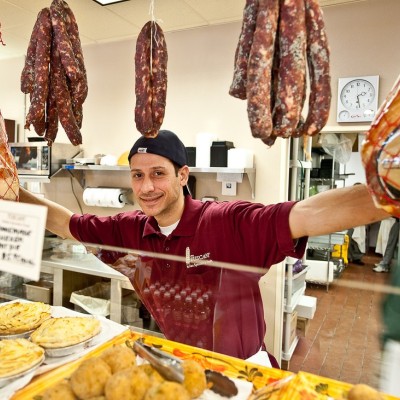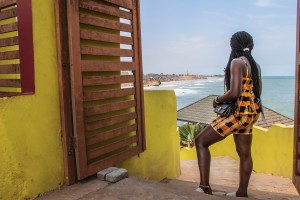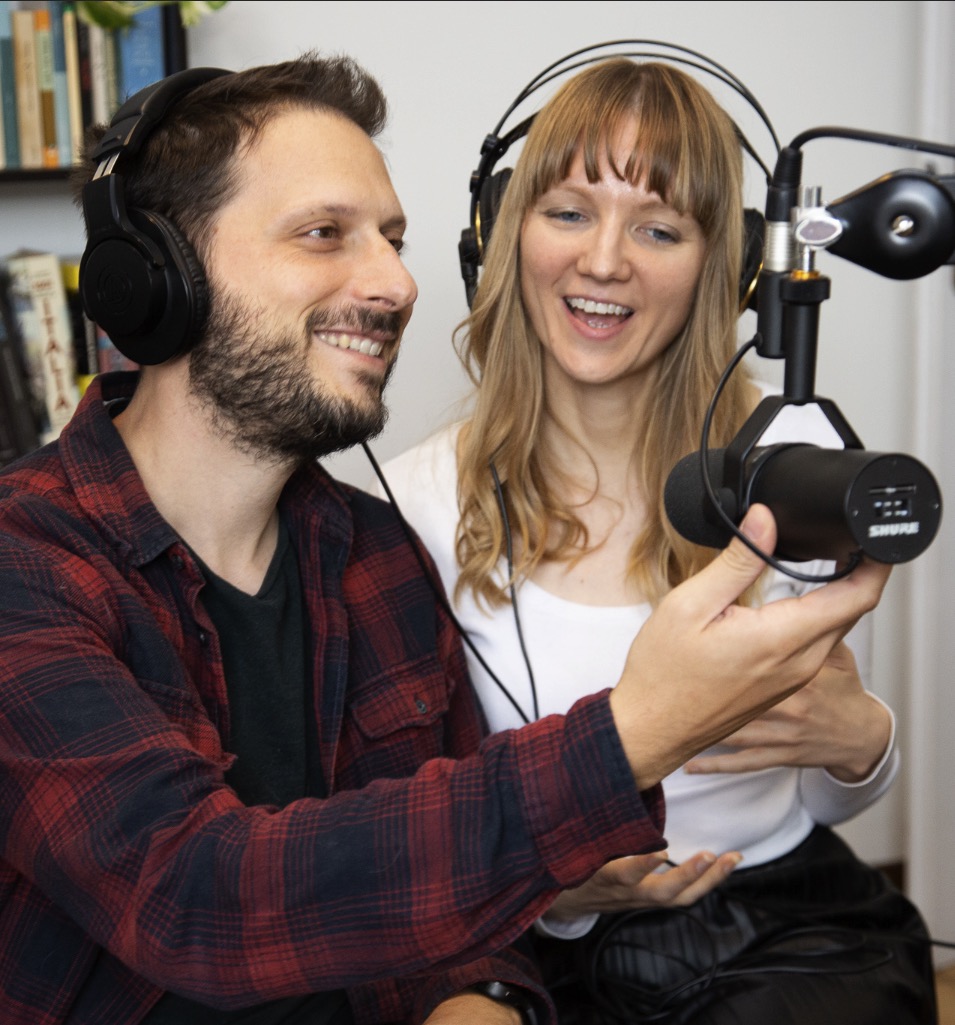Want to learn some handy Italian travel phrases to buy food?
Bene!
In this tutorial, you'll learn how to speak Italian in supermarkets, delis and markets. It includes 3 Italian audio lessons, where you’ll learn the following skills:
- How to ask for things in supermarkets
- The right way to order food at the deli counter
- How to pay for things at the till
How can I remember Italian words and phrases?
One of the hardest parts about learning a language is remembering all that vocabulary! To make new words and phrases stick, it’s important to review them regularly. That’s why we’ve made a set of vocabulary flashcards to go with each lesson. These are like digital "cards" with the Italian phrase on one side and the English translation on the other. You can use them to:- Quiz yourself on the new Italian words and phrases.
- Keep reviewing what you learnt, so you don't forget it.
Italian travel phrases: How to ask for things in supermarkets
5 Minute Italian Lesson Transcript
Katie: Ciao a tutti e benvenuti a 5 minute Italian, hi everyone and welcome to 5 minute Italian. I’m Katie… Matteo: And I’m Matteo. Ciao. K: And in today’s lesson, we’re going to learn how to find our way around an Italian supermarket. We’re going to start with a little dialogue in Italian. Listen and see how much you can make out, then we’ll talk you through the details after. Imagine you’re in the supermarket, but you don’t know where anything is. So you go up to the poor shop assistant, il commesso, and you start asking loads of questions.Italian dialogue
Katie: Mi scusi, dove sono i carrelli? Matteo: Sono lì, all’entrata. Katie: OK grazie. E… dove sono le banane? Matteo: Lì, con la frutta. Katie: Perfetto. E...Dov’è la pasta? Matteo: è di la signora. Katie: Grazie, quale corridoio? Matteo: Corridoio cinque, vicino al pane.What does it mean? Italian travel phrases explained
Katie: So we started with: Mi scusi Matteo: Mi scusi K: Mi scusi, is the formal way of saying “excuse me” with people who you don’t know very well, like shop assistants. You can also use it to say sorry, for example if you get in someone’s way, you can say mi scusi or just scusi. Just a quick reminder that you you can find the main vocabulary from today in the show notes below. M: Then you heard: dove sono i carrelli which means “where are the trolleys”. K: Dove means “where”, sono means “are” and i carrelli means “the trolleys” M: Dove sono i carrelli. K: Then you heard sono lì, all’entrata. M: Which means “they’re there, at the entrance”. Sono lì, all’entrata. K: We know that sono means “are”. Italians often omit the word for they. So instead of saying “they are there”, they just say “are there”. Lì means there. So you can imagine him pointing and saying “there” - lì. M: Sono lì. You might also hear the word là, which means the same thing. To say “there” you can either say lì or là. They’re interchangeable. K: Then you heard all’entrata which means “at the entrance”. The word all means “at the”. And entrata means entrance M: All’entrata. K: And this all is interesting - a means “at” and la means “the” for feminine words, like entrata. In Italian, a and la combine together to give us alla. So to say "at the" for feminine words, you’d get alla. M: but when alla comes before a word which starts with a vowel, we remove the last a sound. So you get all’entrata. K: Sometimes it can help to see this visually, so remember you can find this written down in the show notes below the podcast. Next, I said dove sono le banane which I’m sure you can guess means “where are the bananas?” M: dove sono le banane? K: Then Matteo replied… M: Lì, con la frutta. K: We know that lì means “there”. Con means “with”. And la frutta means the fruit. M: Then Katie said: perfetto which of course means “perfect. You should say it with a nice Italian accent: perfetto! K: Then I asked dov’è la pasta which means “where’s the pasta”. K: Next, Matteo said... M: è di la, signora. Which means “it’s over there madam” K: Di là is quite similar to là which means there. Maybe the only difference is that lì or là gives more of an impression of a specific place, so maybe you’re pointing to a specific point while you’re saying it, while di là is more of a general direction. Over there: di là. M: And then I called you Signora, which is the word you use for women. K: It’s like saying “maam” or “madam”, and Italians use it frequently. And I’m very sad about this because in the last few years people have stopped calling me signorina, which is used with girls and young women, and started calling me signora. M: Then you heard grazie, quale corridoio?. K: Quale, means “which” and corridoio means aisle. And this word is nice and easy to remember because it sounds like corridor - so you can imagine the aisle as being a bit like a corridor. M: corridoio. K: Then Matteo said… M: Corridoio cinque, vicino al pane. K: Corridoio cinque of course means corridor 5. Then you heard vicino al pane, which means “close to the bread”. M: Vicino means close and il pane means “the bread”. K: then we’ve got this word al, which is interesting, because it’s similar to what we were saying before when we talked about all’entrata at the entrance. A in Italian means at, but it also means to. Then we have il which means "the" for masculine nouns. "The bread": il pane. So to say “to the”, we say a + il M: a + il combine together to make al. K: So how do you say close to the bread? M: Vicino al pane K: That’s it for today, thanks for listening to 5 minute Italian. If you’d found today’s lesson useful, please subscribe to us on itunes and leave us a review and some stars :) Grazie, and ciao for now, see you next time, or as we say in Italian, K + M: alla prossima!Italian travel phrases: at the supermarket
| English | Italian |
| Il commesso | shop assistant |
| Mi scusi | excuse me |
| Dove sono | where are |
| I carrelli | the trolleys |
| Sono | they are |
| Lì/Là | there |
| All’entrata | at the entrance |
| A | at (also to) |
| La | the (for feminine nouns) |
| Alla | At the (a + la = alla) |
| La banana | the banana (singular) |
| Le banane | the bananas (plural) |
| Con | with |
| La frutta | the fruit |
| Dov’è | where is |
| La pasta | the pasta |
| Di là | over there |
| Signora | madam/ma’am |
| Quale corridoio | which aisle? |
| Vicino | near |
| Vicino al pane | close to the bread |
| A | to (also at) |
| Il | the (for masculine nouns) |
| Al | to the (A + il = al) |
| Il pane |
the bread |
Remember the words and phrases from this lesson
Quiz yourself on the Italian travel phrases you learnt in this lesson with our digital flashcards. Click here to download the vocabulary flashcards: how to ask for things in the supermarket. Not sure how it works? Watch this tutorial.2. Italian travel phrases: How to order things at the deli counter
5 Minute Italian Lesson Transcript
Katie: Ciao a tutti e benvenuti a 5 minute Italian, hi everyone and welcome to 5 minute Italian. I’m Katie… Matteo: And I’m Matteo. Ciao. K: If you go to Italy, something I would highly recommend doing is going to check out the deli counters, in supermarkets or in little shops because they have lots of delicious meats, cheeses and salads. It’s also a great way to start to learn about different types of Italian food that you might see on menus. Let’s imagine we’re in an Italian supermarket at the deli counter. Usually they’ve got one of those little machines where you take a number. So we’ve got our little yellow ticket, now listen to this conversation at the deli counter and see how much you can make out:Italian dialogue
Matteo: Buongiorno, mi dica signora Katie: Un etto di prosciutto M: Crudo o cotto? K: Crudo grazie M: Qualcos’altro? K: Che cos’è quello? M: è la burrata K: Allora prendo due etti di burrata. M: Basta così? K: Si grazieWhat does it mean? Italian travel phrases explained
Katie: So the first thing you heard was Matteo, the man behind the counter, who said Matteo: Mi dica signora K: Mi dica literally means “tell me”. But when Italians use it in these kinds of situations, it’s translation is similar to “what can I do for you?”. M: You might also hear prego in this situation, which means more or less the same thing. K: Yes, one of the many meanings of prego! M: Then, you heard Katie say: un etto di prosciutto. K: un etto means 100 grams, which is around 6 or 7 thin slices. M: you can also say cento grammi, which of course means 100 grams. K: And remember you can read the vocabulary from today’s episode in the show notes. Then Matteo asked the following question: M: Crudo o cotto? K: And this question is about the types of ham. Prosciutto crudo is what we in England would call prosciutto, or parma ham. Crudo means "raw", and it’s called that because prosciutto crudo isn’t cooked - it’s air dried and salted. Cotto means "cooked", so prosciutto cotto is similar to the normal ham you find in England and elsewhere. M: The names of some other common Italian meats are bresaola which is salted Italian beef, and salame, which of course means salami. M: Next, you heard Katie say crudo, grazie. And this is another example of where Italians sometimes use the word grazie, where in english you would normally say please. K: Then, Matteo said: M: Qualcos’altro? K: Which we’ve heard in previous episodes. it means “anything else?” Then, you heard the most important phrase for curious travellers and language learners everywhere: M: Che cos’è quello? K: This means “what’s that?” And it’s a great way to get deeper into conversations with Italians and learn more about the culture and the language. I think I spend my first few months in Italy just pointing and things and saying: che cos’è quello? M: Then you heard: è la burrata. K: Which means “it’s burrata”, which is one of my favourite Italian cheeses. Finally something for the vegetarians! M: Burrata looks a bit like mozzarella, in fact, it’s exactly the same as mozzarella on the outside, but when you cut into it, it’s soft and creamy on the inside. K: Other examples of nice Italian cheeses are Parmigiano, which means parmesan of course, then Fontina, a soft aged cheese from Aosta Valley in the north, and Pecorino, which literally means “little sheep” - it’s a hard, salty cheese made from sheep’s milk. M: And don’t forget Mozzarella di bufala, which means buffalo mozzarella, the famous cheese of Naples. K: Matteo’s biased because he’s from Naples so he prefers Neapolitan food! Then you heard… M: Allora prendo due etti di burrata K: Allora is one of those very famous Italian words you hear everywhere. It means “so”, or “well”. M: And italians often use it to start a sentence. Allloooorrra... K: Prendo literally means “I take”, but Italians use it to say “I’ll have”, when they’re ordering. Then you heard the plural version of etto. Before we heard the singular version: un etto, with an o at the end. The plural of etto is etti. So you get un etto, but due etti, tre etti and so on. M: Finally, you heard: basta cosi? K: Basta cosi literally means “enough like this?” but Italians use it to say “is that everything?” M: Basta cosi? You might also hear: a posto cosi? Which literally means “OK like this?” K: Let’s listen to the conversation again. M: Buongiorno, mi dica signora K: Un etto di prosciutto M: Crudo o cotto? K: Crudo grazie M: Qualcos’altro? K: Che cos’è quello? M: è la burrata K: Allora prendo due etti di burrata. M: Basta così? K: Si grazie K: Right so that’s it for today’s episode - and we’re taking a little break in August, as it’s 36 degrees right now in the city, so we’re doing what all Italians do and we’re going to escape to the seaside for a couple of weeks. We’ll be back in September with some new episodes. In the meantime, if you’d like to get bonus materials for future episodes, including the transcripts of our conversation, you can subscribe to our mailing list. Ciao for now, or as we say in Italian, K + M: Alla prossima!Italian travel phrases: At the deli counter
| Mi dica | What can I do for you? (literally: tell me) |
| Un etto | 100 grams |
| Prosciutto crudo | Parma ham |
| Prosciutto cotto | ham |
| Bresaola | dried salty beef |
| Salame | salami (nice and easy!) |
| Che cos’è quello | What’s that? |
| La burrata | Cheese which is like mozzarella on the outside, but creamy on the inside |
| La fontina | soft aged cheese from Aosta Valley |
| Pecorino | a hard, salty sheep’s cheese |
| Allora | well/so |
| Prendo | I’ll have… (literally - I’ll take) |
| Due etti | 200 grams |
| Basta così? | Is that everything? (literally: enough like this?) |
| A posto così? | Is that everything? (literally: ok like this?) |
Remember the words and phrases from this lesson
Quiz yourself on the Italian travel phrases you learnt in this lesson with our digital flashcards. Click here to download the vocabulary flashcards: how to order things at the deli counter. Not sure how it works? Watch the tutorial here.3. Italian travel phrases: How to pay for things at the till
https://soundcloud.com/5-minute-italian/episode-285 Minute Italian Lesson Transcript
Katie: Ciao a tutti e benvenuti a 5 minute Italian, hi everyone and welcome to 5 minute Italian. I’m Katie… Matteo: And I’m Matteo. Ciao. K: In the last couple of lessons, we’ve been learning how to order things in shops and supermarkets. This week, we’re going to continue this theme by learning how to pay for things at the till. So let’s practice a typical conversation at the till in Italy.Italian dialogue
Katie: Buongiorno Matteo: Buongiorno. Sachetti? K: Si, due grazie… quant’è? M: Sono venti e cinquanta. K: Posso pagare con la carta? M: Certo. Carta o bancomat? K: Carta. M: Grazie, arrivederci! K: Arrivederci!What does it mean? Italian travel phrases explained
Katie: We started with buongiorno, which is better than ciao in situations like this where you don’t know the person you’re talking to. Matteo: then you heard: Sacchetti? K: Which literally means “bags?” and it’s like asking “would you like a bag?” Shop assistants don’t give bags automatically, they normally ask. M: Then you heard: Si, due grazie. K: Yes, two thank you. Remember with polite replies to questions, Italians don’t say please, they say thank you. Si, grazie. M: To ask for a bag, you can say: posso avere un sacchetto? K: Here we meet again the very useful phrase posso avere which means “can I have”. K: And we’ve got the singular form of the word bag. To say “one bag”, we say: M: Un sacchetto K: With an o at the end: sacchetto. And to say two bags, we say: M: Due sacchetti K: With an i at the end. And you can have tre sacchetti, quattro sacchetti and so on. M: But the word can change depending on the region. In the south of Italy, we usually say busta. K: Which can cause confusion, because it also means envelope. Once one of our friends from Naples walked into a shop in Milan with her hands full and asked for a busta, and the shop assistant stared at her blankly and handed her an envelope. In the supermarket they’ll probably know what you mean, but it can be handy to listen out at the till to learn the regional variation for where you are. You may sometimes hear the word sportina too, M: Then you heard: quant’è? K: Which means “how much is it?” Quanto means “how much” and è means it is. And Italians smush the words together, so you get: Quant’è? M: You can also say: Quanto costa? K: which means: “how much does it cost?” M: And: Quanto viene? K: Viene means “come”. So quanto viene literally means “how much come?” It’s a bit like asking “how much does it come to? M: Next, you heard: Sono venti e cinquanta. K: Can you guess how much that means? Venti e cinquanta literally means “twenty and fifty”. “20 euros 50”. Italians use the word “and” e between the euro and the cents. To introduce the price, they start with the word sono which literally means “they are”. They are twenty and fifty. M: Sono venti e cinquanta. K: If you need some help with numbers, you can go back and check out episodes 14 and 15. Next, you heard: M: Posso pagare con la carta? K: Literally: “Can I pay with the card”, which of course means “can I pay by credit card”. Posso means “can I”, pagare means “pay” and la carta means “the card”. Italians use the word la (the) much more than in English. M: Then you heard: certo K: ...which means “certainly” or “of course”. Next, you heard the question: M: Carta o bancomat? K: Which is a bit of a weird one. Bancomat means debit card. And for some reason in Italy, at the till, they need to know if you’re paying with credit or debit card. Bancomat actually has 2 meanings, it also means cash machine, which is handy to know if you need to get cash out in Italy. M: Let’s listen to the conversation again. K: Buongiorno M: Buongiorno. Sachetti? K: Due grazie. M: Sono venticinque e cinquanta. K: Posso pagare con la carta? M: Certo. Carta o bancomat? K: Carta. M: Grazie, arrivederci! K: Arrivederci! K: If you’d like to get bonus materials, including conversation transcripts, cultural notes, flashcards and invites to our speaking workshops, you can sign up to our mailing list. And if you’re on the list, make sure you check out your emails from us as you’ll find all the bonus materials inside. Ciao for now, or as we say in Italian, K + M: Alla prossima!Italian travel phrases: at the till
| Sachetti? | Would you like a bag? (lit. bags?) |
| Sacchetto/busta/sportina | plastic bag (the difference is regional) |
| Due grazie | Two please (lit. two thank you) |
| Quant’è? | How much is it? |
| Quanto costa? | How much does it cost? |
| Quanto viene? | How much does it come to? |
| Sono venti e cinquanta | It’s twenty euro fifty (lit. they’re twenty and fifty) |
| Posso pagare con la carta? | can I pay by card? |
| Certo | certainly/of course |
| Carta o bancomat? | Credit card or debit card? |
| Bancomat | Debit card/cash machine (two meanings) |
Remember the words and phrases from this lesson
Quiz yourself on the Italian travel phrases you learnt in this lesson with our digital flashcards. Click here to download the vocabulary flashcards: how to order things at the till. Not sure how it works? Watch the tutorial here.Learn to speak and understand faster with 5 Minute Italian
Get Italian lessons + bonus materials delivered to your inbox each week by joining our 5 minute Italian crew. Together with the podcast, we'll send you members only materials including:- Lesson transcripts
- Quizzes
- Vocabulary flashcards
- Lifetime membership to the Facebook group, where you can practise with Italian teachers.
- Invites to online speaking workshops.





